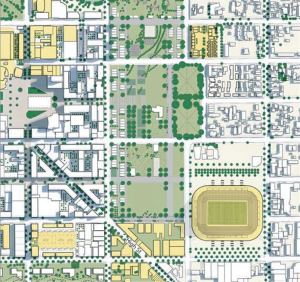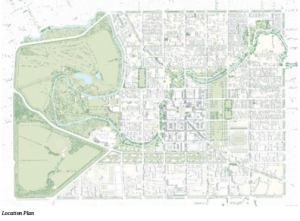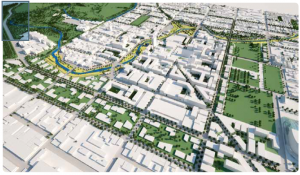It looks like the green highlighter that was used to ‘Wow’ the population of Christchurch in the original Central City Blueprint has faded already.
The images above can be found in the online article from The Press ‘Green space shrunk down to narrow corridor‘:
Land set aside for residential development in the East Frame has grown substantially and green space shrunk to a narrow corridor, a map recently published the Canterbury Earthquake Recovery Authority suggests.
You could be forgiven for not seeing that coming – at least if you relied upon the glossy images that were fore-fronted in the press releases, media coverage, the famous simulated ‘flyover’ and, even, the official Central City Recovery Plan. Here’s a couple more images from that plan (p. 53):
Of course, we have to remember that, as Warwick Isaacs (Central City Development Unit Director) said:
The old map was “a very broad artist’s impression of the East Frame with a lot of detail still to be worked through,”
It was broad enough that the new “concept image” is almost entirely different, although as, once again, Warwick Isaacs notes, let’s not forget even the current image,
identifies a “substantial component of green space running north-south through the East Frame”, Isaacs said.
And,
“These areas are indicative because the process of acquiring land and preparing it future use is still underway.“
It’s also worth remembering that, on page 35 of the Central City Recovery Plan where The Frame is explicitly discussed, it states that
Defining the Core, and providing new green space and a range of commercial and residential development opportunities, the Frame will reshape central Christchurch. Its three components – East, South and North – each have their own distinct character,
That ‘distinct character’ for the East Frame is given on the same page:
East Frame
• City-wide family playground
• Retains the form of historic Latimer Square • Street links through from city to east
• Paths for walking and cycling
• Medium-density demonstration housing and long-term residential development
• Provides link to the stadium and potential fan zone
• Facilitates temporary events
• A significant opportunity through views and vistas to enhance links to geographical landmarks
The more general functions of the overall Frame were given on the same page:
The Frame
• Redefines the central city
• Provides an attractive location for a range of commercial and residential activities
• Articulates the community vision for a green, distinctive, vibrant and accessible city
• Will support a greater choice of housing to attract a diverse range of residents
• Adds visual and open space amenity
• Reduces the need for District Plan rules to control development within the Core which would otherwise be required to address the phasing of development
• Gets people back into the city to enjoy the amenity of the Frame (walking, cycling and playing)
• Provides an alternative cycling and walking network linking the Ōtākaro/ Avon River and Hagley Park
• Provides an attractive campus-style environment for businesses
After reading the words, as opposed to enjoying the images, it’s pretty clear that the Frame was never going to be a swathe of green, open space. It was primarily a mechanism to achieve two things: Increase land prices in the retail precinct; redefine the process of development in the central city.
That’s why the spokesperson for property developers is quite sanguine about the new look:
“Subject to some provisos, it should look good and work fine,” said Connal Townsend [any relation to Chamber of Commerce head, Peter Townsend?], chief executive of the Property Council, a lobby group for developers, investors and banks.
“Yes, there is a less green but there is a green strip.”
A successful East Frame will “hinge on the quality of urban design”, he said.
Di Lucas, a prominent local landscape architect, is also quite pleased:
“The green bit down the middle has got rather slim,” landscape architect Di Lucas said but she praised residential development.
“It’s probably sensible. We need it dense and vibrant. To get it vibrant, we need it dense. To put residential in there is good.”
And CERA and the CCDU, according to Lucas, are not to blame for the misunderstanding of what the East Frame would involve:
“It’s the fault of people in between who assumed that green colouring on a map . . . [meant] green space. It got a momentum of its own.”
It was misleading that the area was sometimes called the “green frame” by people outside Cera.
It was, of course, a little bit more than “green colouring on a map“, as the images above show. Lucas’ comments, however, are useful reminders that ‘Artists Impressions’ are more about PR than reality – a good and timely warning for Christchurch people who are weekly served up ‘artists impressions’ by developers in the central city.
It’s also worth remembering that the “people in between” (??) were not disavowed of their misimpression’s at the time by anyone in CERA, the CCDU or government.
Showing a bit more empathy with the average Christchurch resident, Neil Challenger, a Senior Lecturer at Lincoln University summed up what is probably the general sense amongst the Christchurch population nicely:
“I can understand why people might be surprised and disappointed by the plans now on show,” Neil Challenger a senior lecturer at Lincoln University’s Faculty of Environment, Society and Design. “It’s hard to know quite what that (white space) is, what it means. But it’s clearly a lot more . . . urban and built than most of us had understood was the case.”
In earlier posts I’d expressed scepticism about just how green the Frame would be (see this post) but I can understand why that scepticism wasn’t widespread at the time. In general, most people no longer have the time or inclination to scour these political processes in detail. They tend to trust the general impression that circulates in the popular ether.
It’s all a salutary lesson of how, in our modern world, the population (that’s you and me) is largely treated as a “bewildered herd“, a term made famous by Walter Lippmann.
If we are usefully misinformed, so much the better.
[Postscript: For those wondering, the title is taken from the book ‘How Green Was My Valley‘, by Richard Llewellyn. From the blurb on the site:
Growing up in a mining community in rural South Wales, Huw Morgan is taught many harsh lessons. Looking back, where difficult days are faced with courage and the valleys swell with the sound of Welsh voices, it becomes clear that there is nowhere so green as the landscape of his own memory.]





The just released transport plan also offers many inviting and reassuring pictures. The text tells a truer tale. The community goals Share an Idea brought to the fore are illustrated, but the real focus is on cars and commerce. No doubt things will be better. Sadly too many of the opportunities so dearly purchased have been squandered. We will receive just what Gerry is willing, or forced, to give.
Hi Dirk,
Thanks for taking the time to comment. Yes, it’s the old story of the devil being both in the detail and in the implementation.
It’s not all negative and there’s opportunity to hold decision makers’ ‘feet to the fire’ over the explicit and implicit commitments.
Expressing a view in public doesn’t take too much effort or time but it requires people having taken the time, previously, to find out the details and then feeling ok about voicing their views and confident enough to do it. Too often ‘public debate’ can be seen by most members of the public as something that happens in a mythical realm of ‘experts’, ‘lobbyists’ and ‘activists’.
I think that creates this sense of a split between ‘ordinary’ people and the supposedly collective decisions we make. I also imagine that feeling like there’s no ability to influence decisions, as you note, also discourages people from putting in the effort.
Thanks again for the comment, Dirk!
Regards,
Puddleglum
Thanks for the Walter Lippmann link, I will see what the library has, any suggestions?
Walter seems relivet to the present age of Government which in now able to reach into and monitor every thing we say, write, think and so now able to form a plan to appease us in advance.
He said “The basic problem of democracy, he wrote, was the accuracy of news and protection of sources. He argued that distorted information was inherent in the human mind. People make up their minds before they define the facts, while the ideal would be to gather and analyze the facts before reaching conclusions. By seeing first, he argued, it is possible to sanitize polluted information. And now the Governments and Corporations get to analyze then sanitize.
Love your work Puddleglum
Hi Mr Smith – great to see you commenting here.
This is a pdf of Lippmann’s most famous work, ‘Public Opinion’ which is probably the place to start (or finish!). It also gives a good insight into the ‘elite’, intellectual thought of the time. It starts with the famous quote from The Republic about the cave, shadows and the fire. Hence the quote you mentioned.
And thanks very much for the compliment!
Regards,
Puddleglum
Pingback: It ain’t easy (or accurate) being green | Rebuilding Christchurch
National’s disaster capitalism…
1 – Get residents to voice their ideas of a new city
2 – When residents demand ‘green spaces’, reinterpret this as a ‘green frame’ to increase the CBD land prices by limiting the amount of land
3 – Confiscate land and buildings for a ‘green frame’ and tell Chch they are getting what they asked for
4 – Use powerpoint porn to seduce the people of Chch
5 – Have the City Council change the law so that inner city property developers get a 100% rates rebate
6 – Do nothing for a year and then slowly pretend the ‘green frame’ plan never existed
7 – Change the ‘green frame’ to residential housing
* Whenever people begin to question the plans, just blame the idiot mayor, use the word ‘resilient’, or talk about how big the quake was
Hi fatty,
Thanks so much for the succinct comment. That about sums it up. I take a bit longer in my posts 🙂
Regards,
Puddleglum
Hi Puddleglum. Here is something a little interesting I found in this report that CERA presented to parliament. It’s on page 8, paragraph 3:
“The Blueprint Plan gives direction to the construction of the new central city. It uses a GREEN FRAME to deliver a more compact central city and to provide for a range of commercial and residential development opportunities”
http://cera.govt.nz/sites/cera.govt.nz/files/common/cera-annual-report-2013.pdf
It’s interesting that Di Lucas says that CERA and the CCDU are not to blame for the misunderstanding of what the East Frame would involve and that:
“It’s the fault of people in between who assumed that green colouring on a map . . . [meant] green space. It got a momentum of its own.”
It was misleading that the area was sometimes called the “green frame” by people outside Cera.
According to this report, CERA have done just that and called it the Green Frame in a report to parliament (Because pulling the wool over the eyes of the people of Christchurch just isn”t enough!) I made it to about page 11 of the report then I had to go outside and get some fresh air as I was feeling light headed and sick from all the spin I was reading.
Anyway Puddleglum thank you for all your fantastic posts and insights over the months, keep up the good work
All the Best.
Hi AlexW,
That’s a really interesting bit of ‘sleuthing’. Thanks for letting me (and my few readers :-)) know about it.
A bit rushed but will reply more later.
Definitely get plenty of fresh air – and greenery!
Regards
Puddleglum
Perhaps I’ve missed something, but I’d not seen any govt reports that called the East Frame a ‘Green Frame’. But some Council staff wrongly referred to it as such.
Hi Di,
A good point. But I think there may have been a bit of a ‘bob each way’ approach by those who wrote the Christchurch Central Recovery Plan – that is, not committing to a ‘Green Frame’ but gaining the benefit of people imagining it as a ‘green space’. Here’s the introductory comment from page 3 of the Plan:
“Defining a new central city “Core”, and providing new green space and a range of commercial and residential development opportunities, the “Frame” will reshape central Christchurch. Its three components – East, South, and North – each have
their own distinct character,”
Similarly, on page 5, the map of the ‘Blueprint’ shows a continuous and broad green colour for the Frame and the Avon River Precinct which, at best, ‘blurs the boundaries’ between a dedicated ‘green space’ and a planned ‘non-Green’ Frame I would have thought. Exactly the same point goes for the more ‘official’ map on page 33 (on which the footprints of ‘built’ parts are indicated – e.g., especially in the Innovation Precinct in the ‘corner’). That map also colours the entire Frame the same colour as Hagley Park.
Yes, it was always said to be a place for inner-city residential development but the main amenity value was pushed through reference to public spaces, amenities and access – e.g., the playground, walkways and cycleways.
There’s another sense, I guess, in which we can all agree that the Frame (and much other development of the central city) was intended to be ‘green’. That’s the less literal sense that it would add to the ‘environmentally friendly’ and sustainable (and ‘human friendly’) aspects of the Central City. I would argue that public access to large swathes of the East Frame (whether those swathes be literally ‘green’ or not) would be required for it to be ‘green’ in this latter sense.
Thanks for taking the time to comment – I always appreciate it.
Regards,
Puddleglum
… and so the land thefts continue, though perhaps none quite so blatantly a redistribution of wealth into the hands of the government’s friends and allies than this latest charade:
http://www.stuff.co.nz/the-press/business/the-rebuild/9431531/Bidding-opens-for-bars-shops-homes
erasing a repairable mid-sized entertainment venue that doesn’t fit the “blueprint” by seizing the land, and replacing it with (wait for it) more bars, but ones which will be in the hands of the “right people”:
as this blog observed, some months ago:
“No, that’s not what those exceptional powers have been used for.
Instead, CERA and the Government have brought ordinary Cantabrians to heel whenever necessary; they have provided a warm and safe business environment for the largest and wealthiest property owners; they have threatened compulsory acquisition of land to provide that warm and safe business environment; they have over-ridden property rights for the sake of advancing the interests of those who suffer least.
CERA and the Government have operated on the principle that ordinary people will either simply have to look after themselves or, if they are in the way of grander plans, they’ll have to be forcibly pushed aside, disenfranchised, brought into line or simply be abused (‘carpers and moaners’, ‘buggerising around on facebook all day’)”
Hi bruce,
[I’m not sure why, but your comments were in my spam queue – I released them but deleted one as they were the same comment. Sorry about that – not sure why it happened. PG]
Thanks for the link about the proposed bus interchange development. It was a bit hard to read between the lines about the fate of SoL square. Is that area now ‘up for grabs’ as part of the interchange site development? That would be a tragedy. Are these plans no longer in play, then?
Regards,
Puddleglum
Hi all,
I am excited about the future city of Christchurch, even despite all the above being noted. I’m planning to live in town one day, and planning on heading to the East Frame once I can get accom there (ie next 2 years). Pre-quake I always felt that Christchurch needed more inner city living. That said – getting the balance right between density of urban living (providing people to support the amenities), city amenities (community gardens, tennis courts, coffee shops, etc) and green space. Busy places feel safer and I want to see plenty of people in the green frame, but also don’t want it to have just a slim strip of token green down the middle.
Is there a community group that advocates specifically for residents and future residents of the East Frame?
Thanks
Liz
Hi kiwiliz009,
Some very good points in your comment. Inner city living is certainly ok by me. In fact, I’m a bit disappointed that allowance for that in a way that permeates the entire central city (including the retail precinct) wasn’t made, so far as I’m aware.
I don’t know of any groups presently organising to advocate for residents of the East Frame but if these developments happen (I understand there may be problems over land prices?) they should be of a form that encourages people to organise together in common interest.
Regards,
Puddleglum